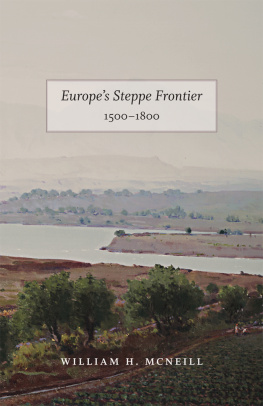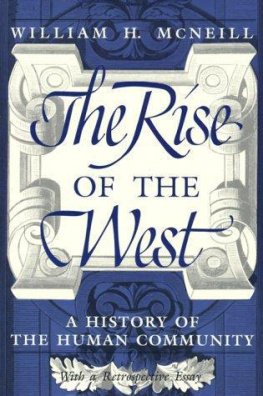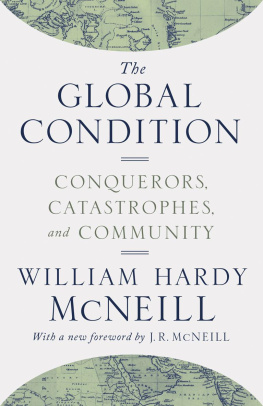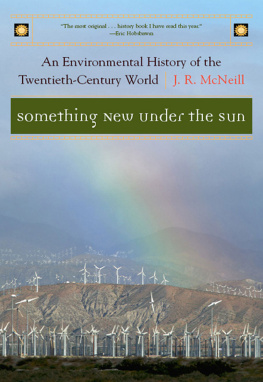PREFACE
The historiography of Danubian and Pontic Europe has been heavily colored by the nationality collisions of the nineteenth and twentieth centuries which so bitterly distracted the last days of the Hapsburg, Russian, and Ottoman empires. Formidable linguistic obstacles have usually inhibited outsiders from attempting to thread a path between the claims of rival national patriotisms. In addition, the traditional compartmentalization of learning, which has assigned the study of Ottoman history to Islamists for whom all too often anything subsequent to the sack of Baghdad by the Mongols in 1258 is anticlimax, has encouraged a neglect of the Ottoman side of the balance. Stubborn and often quite unexamined biases that reflect the fear and hostility with which Christian Europe long regarded the Turks have also clouded Western scholars minds, even in quite recent times and among men for whom the original religious basis of dislike had long since been forgotten.
Since World War II, however, the intensity of the nationality conflicts of eastern and Balkan Europe has begun unmistakably to fade, while the progress of Islamic and Ottoman studies begins to make possible a more balanced understanding of what transpired in the borderlands between the Hapsburg, Russian, and Ottoman states. It is in hope of exploiting these newly opening possibilities that this essay has been written. Mastery of the primary sources upon which scholarship must ultimately rest is beyond me; but it is only when linguistically well-prepared scholars come at their material with well-formulated questions in mind that fruitful and intellectually satisfying history is likely to result. The role of this essay, therefore, is to present a new viewpoint on the tangled tale of Danubian and Pontic Europes past, in the hope that better equipped scholars may in the future use their skills to correct what must at this stage inevitably be fumbling and imperfect initial formulations.
This essay was started during the academic year 1963 as an experiment in bringing seminar work and active historianship together. Distractions allowed only the achievement of a rough draft of the first two chapters before the summer, when temporary liberation from other concerns permitted completion of the whole.
The general point of view here set forth was developed through a course of lectures to graduate students at the University of Chicago, repeated four times during a period of some seven years. Their patient but not uncritical attention was very helpful in compelling me to give definition to my thoughts. Far more active was the contribution of John Renaldo, Frederick Young, and Humberto Nelli, members of my seminar in 1963, whose bibliographical energies and informed criticism was brought to bear on the rough draft of the first two chapters. In addition, the completed manuscript has been read by my colleagues Richard Chambers, Arcadius Kahan, and Donald Lach, and by Marc Raeff of Columbia University. Their suggestions saved me from some errors and confirmed my hope that even so thinly informed an essay as this inevitably remains might be worth putting into print.
W ILLIAM H. McN EILL
January 30, 1964
CHAPTER ONE
INTRODUCTION
Danubian and Pontic Europe comprises the westernmost portion of the Eurasian steppe. Before men altered the landscape by their agricultural and other activities, this broad ribbon of grass snaked its way across most of the Eurasian continent, extending from Manchuria in the east to the Hungarian plain in the west. To the north lay the forests; to the south through most of its length, the steppe grasslands shaded off into desert. The pattern broke up in the European portion of the steppe. A more abundant rainfall meant both a richer growth of grass and the possibility that topographic irregularities, by creating local water catchments, might increase ground moisture to a point at which trees could flourish. Hence in Danubian and Pontic Europe wooded hills and mountain slopes intersected the grasslands, and in the valley bottoms watercourses usually flowed through ribbons of forested land.
This more variegated natural landscape arose from the fact that Danubian and Pontic Europe is a region where the Eurasian steppe intersects the main mountain system of the eartha system that runs from the Pyrenees and Alps, via the mountains of Asia Minor, Iran, and Tibet all the way to the Pacific coast and then sweeps in a great arc around the entire Pacific basin to Tierra del Fuego. To be sure, Europes principal ranges run south of the Hungarian, Rumanian, and Ukrainian plains; but the spume of mountains thrown off to the north, constituting the Carpathians (together with their westerly extensions into Bohemia) and the similar spur that rises out of the Black Sea to constitute the mountains of the Crimea, differentiated our region from the wider steppe lands further east.
The mountain ranges are so arranged that, together with the Black Sea, they break up the region into a number of distinct plains, divided from one another by high and forested ground, and linked by waterways. Thus, if one follows the Danube from its Alpine sources downstream, through most of its length the plains it traverses are almost completely ringed round by mountains. Only after bursting through the Carpathian barrier at the Iron Gates does wider and more open country, characteristic of the Eurasian steppe, begin. Yet even here there is an anomaly, for the Danube flows into a sea which empties through still another narrow water gap that cuts southward through the earths main mountain barrierthe straits of the Bosphorus and Dardanelles. The lengthy and, for the most part, slow-moving rivers that flow into the Black Sea from the forested zones of the north, together with the Danube itself, offered ready-made roadways for the transport of goods and men, and made possible trade and river-raiding, even across long distances, in early as in more recent times.
Movement along the major rivers cut across the width of the steppe. But the grass sea was itself a broad and almost undifferentiated highway for those who had mastered the arts of horse nomadry. Nomads could move to and fro at will, either peaceably in search of pasture for their flocks or with other purposes in view: flight, plunder, or trading, as the case might be. The general axis of this sort of movement was east-west, for horsemen had always to move within regions where adequate forage for their mounts could be found, i.e., had to stay within range of the natural grasslands of the steppe. Hence Danubian and Pontic Europe may also be defined as a region where the transcontinental gallop intersected the interregional river boat (in winter, sleigh).











 This paper meets the requirements of ANSI/NISO Z 39.48-1992 (Permanence of Paper).
This paper meets the requirements of ANSI/NISO Z 39.48-1992 (Permanence of Paper).